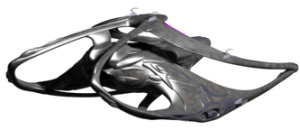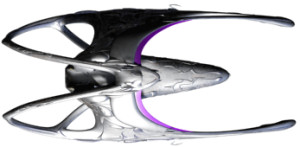
| Elorg • Andrinel Class |
| TYPE |
| Andrinel Class Heavy Cruiser |
| COMMISSIONED |
| 2399 - present |
| UNIT RUN |
| EWS Andrinel • EWS Ven'dyr • EWS Tal'drassil • EWS Naltyere Plus several-thousand additional vessels believed under construction. |

| LENGTH: 812.94 m BEAM: 362.50 m HEIGHT: 164.38 m DECKS: 26 |
| DIMENSIONS |
| CREW |
| 770; 6000 evacuation limit |
| ARMAMENT |
| 1 x heavy beam disruptor canon, total output 233,958 TeraWatts 4 x burst torpedo tubes +475 graviton torpedoes |

| DEFENSE |
| Regenerative shield system, total capacity 6,241,000 TeraJoules Advanced biomolecular double hull +9.3cm density ablative armor High Level Structural Integrity Field |
| PROPULSION |
| NORMAL CRUISE: Warp 11.0 MAXIMUM CRUISE: Warp 15.7 MAXIMUM SPEED: Warp 17.3 for 6 hours |

| STRENGTH INDEX Galaxy Class = 1000 |
| BEAM FIREPOWER: 4,679 TORPEDO FIREPOWER: 10,800 WEAPON RANGE/ACCURACY: 1,997 SHIELD STREGNTH: 2,311 HULL ARMOR: 1,790 SPEED: 1,203 MANEUVERABILITY: 3,505 OVERALL: 5,125 |
| DIPLOMATIC GRADE |
| 3 |
| HULL LIFE |
| 330 years |
| REFIT CYCLE |
| Unknown |

| NOTES |
| The Andrinel-class warship is a sleek, powerful starship developed by the Elorg Bloc in 2398-2399 in preparation for a new campaign against the Federation and its allies. Citing a lack of maneuverability as the biggest flaw in the ancient Inkhezi Class design, Elorg engineers crafted a much smaller vessel, while retaining most of the firepower that made the Inkhezi Class a formidable force on any battlefield. In addition to the single beam disruptor canon on the front of the ship, the Andrinel is equipped with nearly 500 graviton torpedoes... infinitely dense weapons of mass destruction powered by small quantum singularities. It is believed Overseer Xi'Yor stole the technology from the Drusari in early 2398--however, the torpedoes applied here are considerable weaker than a standard graviton torpedo. The Andrinel is also a fast vessel, easily able to exceed warp 17 in extreme situations. |
| ACKNOWLEDGEMENTS |
| The Andrinel-class model (NYX Raising) used throughout this site was created by Lulu Keng. This page was created using information from the Daystrom Institute Technical Library (www.ditl.org) |